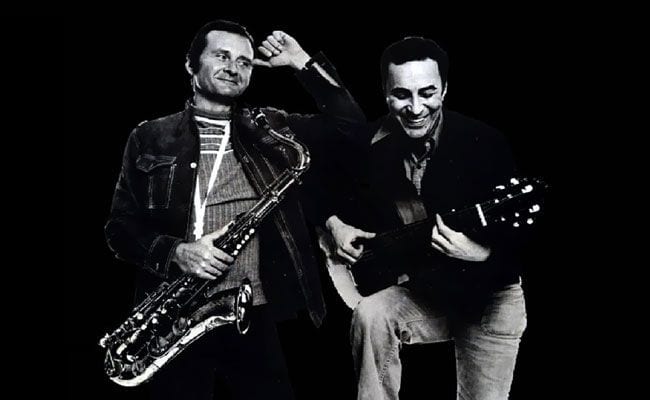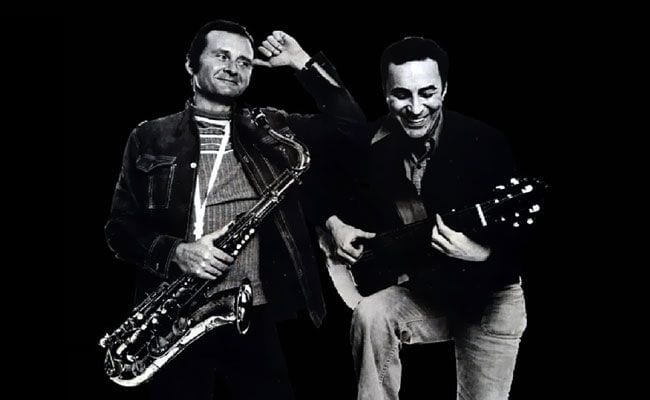
At a time when the 1960s are associated less with Jefferson Airplane than with Mad Men, it’s interesting and wonderful to listen with real care — once again — to the essentially perfect recording Getz/Gilberto. This delicate and artful recording on Verve paired jazz saxophonist Stan Getz with five remarkable Brazilians who were forging a “new trend” in their home country. It produced radio hits and fueled a bossa nova “craze” on college campuses — which is remarkable because this music could not be more understated and peaceful.
“Bossa nova” combined Brazilian samba rhythms with the harmonic sophistication and subtlety of mid-’50s cool jazz. Permanently associated in the public mind with this album’s first track, “The Girl from Ipanema” (one of the many tunes here by Antonio Carlos Jobim, who also plays piano on the recording), the music does seems to reflect the sexy, insinuating vibe of a beach culture. But if the Brazilian samba music that we now hear as we listen to a broadcast of the FIFA World Cup suggests the unbridled exuberance of a wild party, then bossa nova — at least as interpreted by Stan Getz, Joao and Astrud Gilberto, and seminal composer Jobim — is a very quiet evening at home with wine and and good friend.
Getz/Gilberto was released in 1964, and it went on to win the 1965 Grammy for Album of the Year and Best Jazz Instrumental Album — the first and near-only time a jazz record would get such acclaim. But it was not the first American bossa nova success. Getz and guitarist Charlie Byrd released Jazz Samba two years earlier, and Getz won a Grammy for his performance. Both records were produced by the canny Creed Taylor, who clearly heard in this new style something that the public, just then getting a taste for a new war in southeast Asia and for a rising civil rights movement and student movement, might embrace.
It has been easy enough, as the years have passed, to dismiss bossa nova as cocktail schmaltz, as “easy listening”, as a pacifier for the public to suck on before it was ready to really fall in with rock ’n’ roll. It is, after all, quiet and gentle music, perfect “background music” — the kind of thing that even your grandparents would like, regardless of generation.
But that’s unfair for a bushelful of reasons.
Historically, the quietness and subtlety of bossa nova music was the very thing about it that was innovative and, well… bold. The prevailing vocal style in Brazilian samba was loud and operatic. The bossa nova innovators developed their music as a more personal style, one suited to living rooms, to intimacy, to vulnerable expression of feeling and sophisticated, even literary, expression of love and longing and need. The singing was unaffected, with a plain-spoken quality. But the melodies contained all the feeling that was necessary, with long lines that could snake through jazz chord changes or quick pulses that acted like brushes against the head of a snare drum.
By the time Joao Gilberto, his wife Astrud Gilberto (not a professional singer, but one steeped in the burgeoning style to be sure), Tom Jobim, bassist Sebastiao Neto, and drummer Milton Banana came to the A&R studios in New York in 1963, the style was firmly established at home and Getz and Byrd had already whet the public appetite for this lilting and swaying sound. But Getz/Gilberto was a success on a whole different level — both artistic and popular.
Why? Great songs, great rhythm, great singing.
Jazz Samba contained two songs that were really special, both by Jobim: “Desafinado” and “One Note Samba”. The newer recording featured six of eight songs by the master, including new classics “The Girl from Ipanema”, “Corcovado”, and “So Danco Samba”. “Doralice” and “Vivo Sonhando” are amazing songs as well. Each expressed a distinctive and new voice. Jobim’s signature style of songwriting was as immediately identifiable as that of Burt Bacharach or Lennon/McCartney or Sondheim. Here was a craftsman at the height of his work — and this record put it all out there seemingly at once.
Unlike the recording with Charlie Byrd, Getz/Gilberto featured a Brazilian rhythm section, and the difference is notable. Byrd’s group sounds more like a jazz band: with distinctive elements that are conversing in cool little clashes, creating tensions and releases along the way, using the samba rhythms in cross-currents in much the way that jazz players used Latin rhythms at the time. The team on the newer record play these same rhythms, but they do so more like a great pop band: utterly as one. While the music is still fueled by a momentum that comes from polyrhythm, the nylon-stringed guitar, piano, bass, and percussion are fully integrated, like a fluttering cushion beneath the singers and Getz’s sublimely melodic improvisations.
And this beautifully played music sets the table for three singers. Every song features Joao Gilberto (guitar and vocals, both), who had been slowly developing his vibrato-less singing over a decade of quiet thought and collaboration. He sings entirely in Portuguese — even, sensitive, trembling with a sense of feeling. On “Desafinado”, which American ears already knew from the 1962 record, you can hear clearly why Gilberto is such an essential singer. Aside from his pleasing, lilting tone, he takes the familiar melody and he completely rewrites its accents and emphases, running slightly ahead of the beat, then lagging back behind it a moment later. Hearing him is like hearing Louis Armstrong for the first time. He sounds effortless and natural, yet there is a complex art to it that defies easy imitation. It just sounds better than other singing that might be similar. It sounds just right for these songs and this style.
But what Americans understandably latched onto was the singer on just two tracks who provided English lyrics on the two most accessible melodies. On the radio edit of “The Girl from Ipanema”, included on this 50th anniversary edition (along with the radio edit of “Corcovado” and both stereo and mono versions of all eight original tracks), Gilberto hums a quick three-note descending figure over just his guitar before a new voice enters: that of his wife in 1963, Astrud Gilberto, singing the words in English — “Tall and tan and young and lovely / The girl from Ipanema goes walking / And when she passes each one she passes goes ‘Ahhhhhh’.” it was, simply, a star-making performance, as Getz told Astrud during the playback. Her voice, too, is flat and unaffected, cool to the point of ultimate sex appeal, inflected with her accent slightly, and giving off every sense that she knows where and why that “Ahhhhhh” comes from. A second single was made from “Corcovado”, where Atrud sings it as a ballad otherwise known as “Quiet Nights” at the top before the cool breeze of bossa rhythm comes in.
The third voice, of course, is that of Stan Getz himself. Unlike most saxophonists who appear on pop records, Getz gets top billing here. And it’s proper. His “voice” is the straw that stirs the drink because his voice is the most overtly expressive, the ripest, rich in vibrato and jazz syncopation. Getz’s tone, of course, is legendary. (Coltrane allegedly said, “We’d all sound like him if we could.”) But here it’s his rhythmic agility and ability to stick to the melody just enough while also making critical, memorable embellishments. Every one of his solos elevates the heat of the band, just by a few degrees perhaps, but enough so that when Astrud re-enters with the bridge on “Ipanema”, it’s like feeling a cool mist hit your skin after spending a pleasant few minutes in the hot sun.
On track after track, this mixture of voices brings a listener pleasure and surprise. The quick “Doralice” is famous for the delicious sound of Getz’s saxophone pads slapping against the holes — that’s how quiet and subtle the music is, even the percussive sounds the tenor makes are critical to the groove. The fast eighth-note pattern on Banana’s hi-hat cymbal on “So Danco Samba” is a dream, so steady and yet modulated slightly in volume, but then when Gilberto takes a quick and audible inhalation of breath before the last note of the melody’s A section or when he sings “cha cha cha” very quickly and in syncopation.
Does this reissue improve on older versions of Getz/Gilberto that you might already have in your collection? The main “extra” is the inclusion of both the stereo and mono versions — a matter of taste, I suppose. If you are a little older than me and actually remember these tunes being played on AM radio back when your dad was getting on the train, wearing his fedora to head off to Madison Avenue, then the mono versions are sublime, I think. The stereo “Ipanema” puts Gilberto’s voice right in the middle and then shunts Astrud off to the left channel, mostly. Beyond that, well, great music is great music.
What is remarkable is how this remnant of an era — a style that Mad Men did feature in some ads and incidentally — now feels utterly timeless. It’s not just that jazz musicians still play bossa novas today, fifty years later; it’s that the music as it was created back then still sounds modern, lean, beautiful, perfect.


![Call for Papers: All Things Reconsidered [MUSIC] May-August 2024](https://www.popmatters.com/wp-content/uploads/2024/04/all-things-reconsidered-call-music-may-2024-720x380.jpg)



